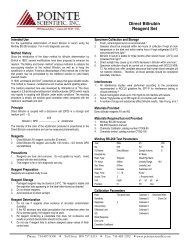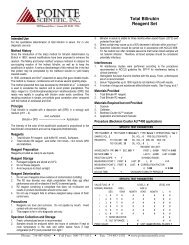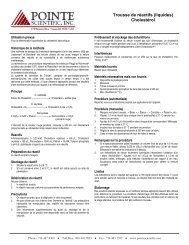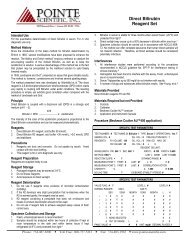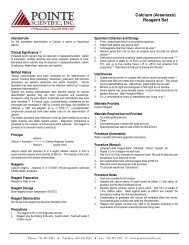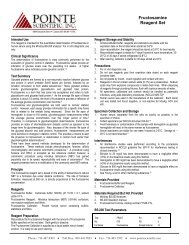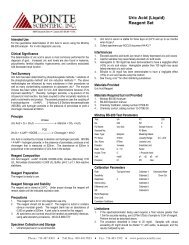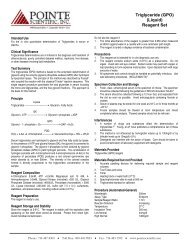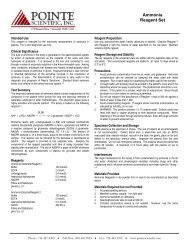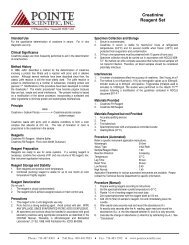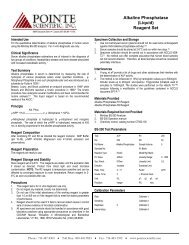H7545 - Pointe Scientific, Inc.
H7545 - Pointe Scientific, Inc.
H7545 - Pointe Scientific, Inc.
Create successful ePaper yourself
Turn your PDF publications into a flip-book with our unique Google optimized e-Paper software.
Liquid<br />
autoHDL TM Cholesterol<br />
Reagent Set<br />
Intended Use<br />
For the quantitative determination high-density lipoprotein cholesterol in<br />
human serum or plasma. For in vitro diagnostic use only.<br />
Summary<br />
Lipoproteins are spherical-shaped particles that contain varying amounts of<br />
cholesterol, triglycerides, phospholipids and proteins. The phospholipids and<br />
proteins make up the outer surface of the lipoprotein particle, while the core<br />
consists mostly of cholesterol in the esterified form and triglycerides. The<br />
purpose of the lipoprotein particles is to transport cholesterol and triglyceride<br />
through the bloodstream.<br />
The relative amounts of the protein and lipid constituents determine the<br />
density of the lipoprotein particles and provide a basis for their classification. 1<br />
These classes are: chylomicron, very-low-density lipoprotein (VLDL), lowdensity<br />
lipoprotein (LDL) and high-density lipoprotein (HDL). There have<br />
been many clinical studies that have shown that these lipoprotein particles<br />
have very distinct and varied effects on the risk of coronary heart disease. 2<br />
The role of HDL particles in lipid metabolism is primarily the uptake and<br />
transport of cholesterol from peripheral tissue to the liver. This process is<br />
known as reverse cholesterol transport and has been proposed as a cardio<br />
protective mechanism. 3 Low HDL-C levels have repeatedly been associated<br />
with an increased risk of coronary heart disease and coronary artery<br />
disease. 4-9 Thus, the determination of serum HDL cholesterol has been<br />
recognized as a useful tool in identifying high-risk patients. The Adult<br />
Treatment Panel of the National Cholesterol Education Program (NCEP)<br />
recommends that all adults 20 years of age and over should have their total<br />
cholesterol and HDL cholesterol levels measured at least every 5 years to<br />
screen for risk of coronary heart disease. 9<br />
The CDC reference method for HDL cholesterol uses ultracentrifugation<br />
followed by chemical precipitation to separate HDL from other lipoproteins,<br />
followed by cholesterol measurement using a modified Abell-Kendall<br />
assay. 10 This method is considered too time consuming and labor intensive<br />
for use in routine analysis. 11 Historically, most laboratories have used one of<br />
several methods for the selective precipitation and removal of LDL and<br />
VLDL, followed by the enzymatic measurement of HDL-C in the supernatant<br />
fraction. 10 Since almost all of these methods required manual separation<br />
steps, HDL cholesterol determinations could not be fully automated. Also,<br />
the dilution of the sample resulted in an enzymatic determination of<br />
cholesterol with low sensitivity. As a result, the routine determination of HDL<br />
cholesterol has suffered from both long turnaround times and poor<br />
reproducibility.<br />
Principle<br />
The Liquid autoHDL TM Cholesterol assay is a homogeneous method for<br />
directly measuring serum HDL-C levels without the need for any off-line<br />
pretreatment or centrifugation steps. The method is in a two-reagent format.<br />
The first reagent contains α-cyclodextrin and dextran sulfate to stabilize LDL,<br />
VLDL, and chylomicrons. The second reagent contains PEG modified<br />
enzymes that selectively react with the cholesterol present in the HDL<br />
particles. Consequently, only the HDL cholesterol is subject to cholesterol<br />
measurement.<br />
Reagents<br />
R1: α-cyclodextrin 0.5 mM, dextran sulfate 0.5g/L, magnesium chloride 2.0mM,<br />
HSDA 0.3 g/L, buffer, pH 7.0 ± 0.1, preservative.<br />
R2: POD>15,000 U/L, PEG-CO>5,000U/L, PEG-CE>800 U/L, 4-aminoantipyrene<br />
0.5 g/L, buffer, pH 7.0 ± 0.1, surfactant, preservative.<br />
HSDA = Sodium N-(2-hydroxy-3-sulfopropyl)-3,5-dimethoxyaniline.<br />
PEG-CO = Cholesterol Oxidase from Nocardia sp.<br />
PEG-CE = Cholesterol Esterase from Pseudomonas<br />
POD = Peroxidase from Horseradish<br />
Reagent Preparation<br />
Reagent 1: Reagent 1 is ready to use.<br />
Reagent 2: Reagent 2 is ready to use.<br />
Reagent Storage and Stability<br />
All reagents are stable until the expiration date on the kit label when stored at 2-<br />
8°C.<br />
Precautions<br />
1. For in vitro diagnostic use.<br />
2. Do not pipette by mouth.<br />
3. All specimens used in this test should be considered potentially infectious.<br />
Universal precautions as they apply to your facility should be used for<br />
handling and disposal of materials during and after testing.<br />
4. Do not use the reagent after the expiration date printed on the kit.<br />
Specimen Collection and Preparation<br />
Serum, EDTA-treated or heparinized plasma are the recommended specimens.<br />
Serum: Collect whole blood by venipuncture and allow to clot. Centrifuge and<br />
remove the serum as soon as possible after collection. (within 3 hours). 10<br />
Plasma: Specimens may be collected in EDTA or heparin. Centrifuge and<br />
remove the plasma as soon as possible after collection (within 3 hours). 10<br />
If not analyzed promptly, specimens may be stored at 2-8°C for up to 1 week. If<br />
specimens need to be stored for more than 1 week, they may be preserved at less<br />
than -20°C for up to 1 month. For storage periods of 1 month to 2 years, samples<br />
should be preserved at -70°C. 10<br />
Interferences<br />
All interference studies were conducted according to the procedures<br />
recommended in NCCLS guideline NO. EP7-P for interference testing in clinical<br />
chemistry. 12 Hemoglobin levels up to 100 mg/dl and Bilirubin levels up to 20mg/dl<br />
were found to exhibit negligible interference (
Liquid<br />
autoHDL TM Cholesterol<br />
Reagent Set<br />
Materials Required but not Provided<br />
1. An autoHDL/LDL Cholesterol Calibrator.<br />
2. HDL cholesterol controls<br />
3. Automated clinical chemistry analyzer capable of accommodating tworeagent<br />
assays.<br />
Procedure<br />
Below is a general example of the autoHDL TM test procedure for an<br />
automated analyzer. All analyzer applications should be validated in<br />
accordance with NCEP and CLIA recommendations. 10 For assistance with<br />
applications on automated analyzers, please contact the Technical Service<br />
Department.<br />
37°C 37°C<br />
Sample + Reagent 1 ---- Reagent 2 ---- Measurement (Absorb. Difference<br />
4ul 300ul 5min. 100ul 5min. between 700nm & 600nm)<br />
I<br />
I<br />
I<br />
V<br />
HDL-C Result<br />
Limitations<br />
1. Anticoagulants containing citrate should not be used.<br />
2. Protect the reagents from direct sunlight.<br />
3. Store the reagents as per instructions.<br />
4. Samples with values greater than 150 mg/dl must be diluted 1:1 with<br />
saline and re-assayed. Multiply the result by two.<br />
Calibration<br />
The autoHDL/LDL TM Cholesterol Calibrator is required for calibration. The<br />
value of the autoHDL/LDL TM calibrator was assigned by procedures<br />
traceable to the National Reference System for Cholesterol (NRS/CHOL).<br />
Refer to autoHDL/LDL TM Cholesterol Calibrator kit package insert for<br />
instructions. If control results are found to be out of range, the procedure<br />
should be recalibrated.<br />
Quality Control<br />
Reliability of test results should be routinely monitored with control materials<br />
that reasonably emulate performance of patient specimens. 10 Quality control<br />
materials are intended for use only as monitors of accuracy and precision.<br />
The National Cholesterol Education Program (NCEP) Lipid Standardization<br />
Panel (LSP) recommends two levels of controls, one in the normal range<br />
(35-65 mg/dl) and one near the concentrations for decision making<br />
(
Liquid<br />
autoHDL TM Cholesterol<br />
Reagent Set<br />
3. Precision: Within Day precision for the Liquid autoHDL TM Cholesterol<br />
Reagent was determined following a modification of NCCLS document<br />
EP5-T2. 15 Within Day precision studies produced the following results:<br />
LOW MID HIGH<br />
n 20 20 20<br />
Mean HDL Cholesterol (mg/dl) 38 68 85<br />
Standard Deviation (mg/dl) 0.9 1.0 1.2<br />
Coefficient of Variation (%) 2.2 1.5 1.4<br />
Day to Day precision for the Liquid autoHDL TM Cholesterol Reagent<br />
was also determined following a modification of NCCLS document<br />
EP5-T2. 15 Day to Day precision studies produced the following results:<br />
LOW MID HIGH<br />
n 20 20 20<br />
Mean HDL Cholesterol (mg/dl) 37 66 84<br />
Standard Deviation (mg/dl) 0.8 1.5 1.6<br />
Coefficient of Variation (%) 2.2 2.3 1.9<br />
4. Sensitivity: The analytical sensitivity of the Liquid autoHDL TM<br />
Cholesterol Reagent was determined to be 0.002 absorbance units per<br />
1 mg/dl of HDL Cholesterol.<br />
13. Young, D.S., Effects of Drugs on Clinical Laboratory Tests, 3 rd . Ed., AACC<br />
Press, Washington DC, 1990, 3-104 thru 3-106.<br />
14. Tietz, N.W., Clinical Guide to Laboratory Tests, W.B. Saunders Co.,<br />
Philadelphia, 1986, p.256.<br />
15. NCCLS document “Evaluation of Precision Performance of Clinical<br />
Chemistry Devices” 2 nd Ed. 1992.<br />
Rev. 10/12<br />
Manufactured for <strong>Pointe</strong> <strong>Scientific</strong>, <strong>Inc</strong>.<br />
5449 Research Drive Canton, MI 48188<br />
European Authorized Representative:<br />
Obelis s.a.<br />
Boulevard Général Wahis 53<br />
1030 Brussels, BELGIUM<br />
Tel: (32)2.732.59.54 Fax:(32)2.732.60.03<br />
P803-<strong>H7545</strong>-01<br />
email: mail@obelis.net<br />
References<br />
1. Gotto A.M., Lipoprotein metabolism and the etiology of hyperlipidemia,<br />
Hospital practice, 23:Suppl.1,4 (1988).<br />
2. Crouse J.R. et al, Studies of low density lipoprotein molecular weight in<br />
human beings with coronary artery disease, J. Lipid Res., 26:566<br />
(1985).<br />
3. Badimon J.J., Badimon L., Fuester V., Regression of Atherosclerotic<br />
Lesions by High-Density Lipoprotein Plasma Fraction in the<br />
Cholesterol-Fed Rabbit, Journal of Clinical Investigation, 1990;<br />
85:1234-41.<br />
4. Castelli, W.P., et al, Cholesterol and other lipids in coronary heart<br />
disease, Circulation, 55:767 (1977).<br />
5. Barr, D.P., Russ E.M., Eder H.A., Protein-lipid relationships in human<br />
plasma, Am. J. Med. 11:480 (1951).<br />
6. Gordon, T., et al, High density lipoprotein as a protective factor against<br />
coronary heart disease, Am. J. Med., 62:707 (1977).<br />
7. Williams, P., Robinson D., Baily A., High density lipoprotein and<br />
coronary risk factor, Lancet, 1:72 (1979).<br />
8. Kannel W.B., Castelli W.P, Gordon, T., Cholesterol in the prediction of<br />
atheriosclerotic disease; New perspectives based on the Framingham<br />
study, Am. Intern. Med., 90:85 (1979).<br />
9. National Institute on Health publication No. 93-3095, September 1993.<br />
10. Warnick G. Russell, Wood Peter D., National Cholesterol Education<br />
Program Recommendations for Measurement of High-Density<br />
Lipoprotein Cholesterol; Executive Summary Clinical Chemistry, Vol.41,<br />
No. 10 (1995).<br />
11. Grundy, S.M., et al, Summary of the Second Report of the National<br />
Cholesterol Education Program (NCEP) Expert Panel on Detection,<br />
Evaluation, and Treatment of High Blood Cholesterol in Adults (Adult<br />
Treatment Panel II), JAMA 1993, 269: 23, 3015-3023.<br />
12. National Committee for Clinical Laboratory Standards, National<br />
Evaluation Protocols for Interference Testing, Evaluation Protocol<br />
Number 7, Vol.4, No. 8, June 1984.<br />
Phone: 734-487-8300 • Toll Free: 800-757-5313 • Fax: 734-483-1592 • www.pointescientific.com



